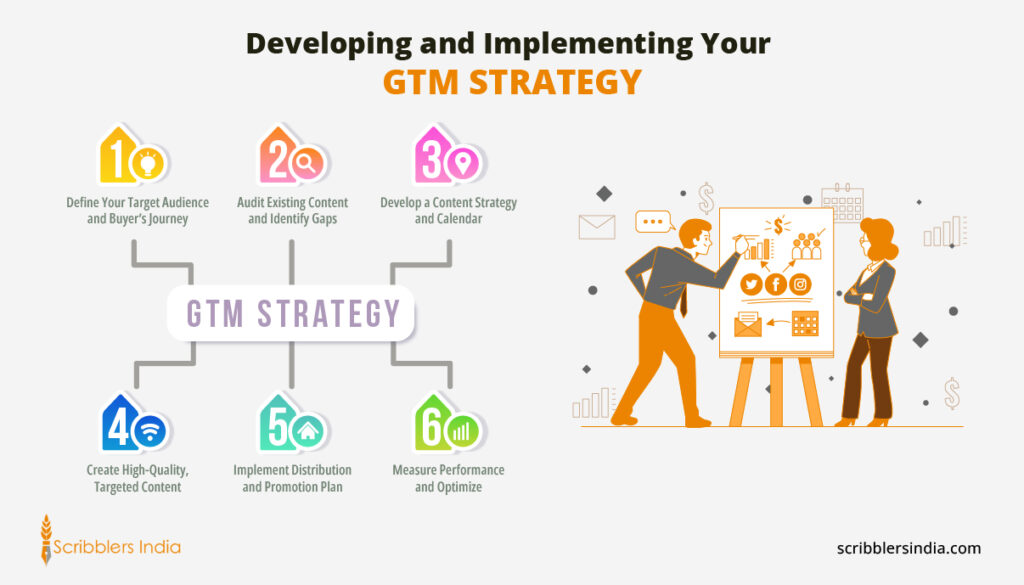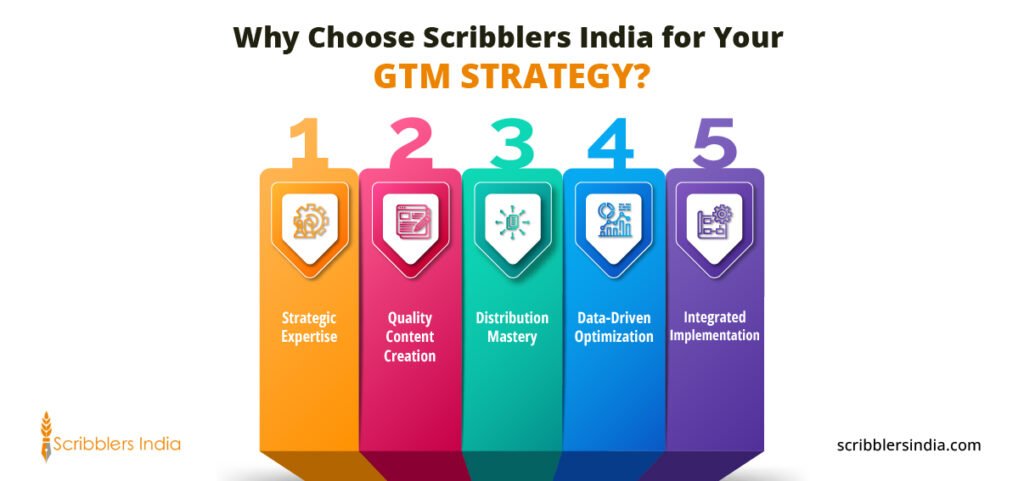The rise of self-service buying journeys and information-empowered customers has transformed how successful companies introduce products to market. According to a study by Gartner, 75% of business buyers prefer a red-free sales experience. This fundamental shift in buyer behavior has given rise to businesses adopting a content-led go-to-market strategy.
This approach leverages high-quality content as the primary driver of awareness, education, and conversion throughout the customer journey. This blog explores the key facets of a content-led GTM strategy along with an analysis of successful real-world examples to help you understand its effectiveness.
What is a content-led go-to-market strategy?
A content-led go-to-market strategy uses strategic content assets as the primary driver to attract, educate, and convert customers when launching a product or entering a new market. This approach positions valuable information ahead of sales outreach, allowing customers to self-educate and move through buying stages at their own pace.
Unlike traditional GTM approaches that rely heavily on outbound sales motions, a content-led GTM strategy empowers prospects to discover and evaluate your offering through educational content, thought leadership, and product information. This aligns with modern buying preferences, where customers increasingly expect to research and evaluate products on their terms before engaging with sales representatives.
This go-to-market approach is particularly effective for complex offerings that require education and for reaching audiences skeptical of traditional marketing and sales tactics. According to recent research, 80% of decision-makers prefer to get information from articles rather than advertisements.
What are the key components of a go-to-market strategy?
A comprehensive go-to-market strategy includes market analysis, target audience definition, value proposition, competitive positioning, pricing strategy, channel selection, sales approach, and success metrics. Content plays a critical role in communicating each component effectively to your target audience.
A successful GTM strategy requires alignment across multiple business functions:
- Market Analysis: Understanding market dynamics, size, and growth opportunities helps focus your content marketing for product launch efforts on the most promising segments and pain points.
- Target Audience: Detailed buyer personas guide content creation by revealing specific challenges, information needs, and preferred content formats for each decision-maker in the buying process.
- Value Proposition: Your unique value must be clearly articulated through content that communicates specific benefits rather than just features, helping prospects understand why your solution matters.
- Competitive Differentiation: Content that highlights your unique advantages helps position your offering distinctly in the market, addressing common competitive objections before they arise.
- Channel Strategy: Identifying the most effective channels for content distribution ensures your message reaches your audience where they already seek information about solutions like yours.
In a content-led go-to-market strategy, each of these components is supported by specific content types designed to address customer questions and move prospects through their buying journey without heavy reliance on sales intervention.
How does a content-led GTM strategy deliver growth?
A content-led GTM strategy delivers growth by building trust through education, shortening sales cycles, reducing customer acquisition costs, scaling more efficiently than sales-led approaches, and providing valuable data for continuous optimization. This approach aligns with how modern buyers prefer to purchase.
The growth impact of this approach is substantial for several reasons:
- Trust Building: By focusing on customer education rather than product promotion, you establish authority and credibility early in the relationship. Most successful B2B content marketers aim to ensure that their audience views their organization as a credible and trusted resource.
- Self-Service Purchasing: Modern buyers prefer self-directed research, with most completing over 72% of their evaluation process before contacting vendors. Content-led approaches enable this preferred buying behavior, removing friction from the purchase process.
- Compounding Returns: Unlike paid advertising that stops working when you stop paying, quality content continues generating leads and conversions long after creation.
- Data-Driven Insights: Content engagement provides valuable signals about prospect interests, challenges, and buying readiness that can inform both content optimization and product development.
A well-executed content-driven go-to-market approach creates a sustainable engine for attracting qualified prospects while building a valuable content library that continues delivering returns over time.
How to develop and implement a content-led GTM strategy?
Developing an effective content-led GTM strategy involves mapping buyer journeys, identifying content gaps, creating strategic assets, implementing distribution plans, measuring performance, and optimizing based on results. Each step ensures your content effectively supports your market entry goals.
1. Define Your Target Audience and Buyer’s Journey
Start by creating detailed buyer personas that capture not just demographics but information needs at each stage of the purchase process. Map the specific questions and concerns prospects have as they move from awareness to consideration to decision, identifying content opportunities for each stage.
2. Audit Existing Content and Identify Gaps
Evaluate your current content assets against the buyer journey map to identify coverage gaps. Where are prospects likely to get stuck due to missing information? Which competitor objections remain unaddressed? This gap analysis becomes your content creation roadmap.
3. Develop a Content Strategy and Calendar
Create a strategic content plan that addresses identified gaps while maintaining consistent messaging across all assets. Your plan should include content types, topics, publishing cadence, and responsibilities. According to Semrush’s research, companies with documented content strategies are 3x more likely to report success.

4. Create High-Quality, Targeted Content
Develop content assets that directly address buyer needs at each journey stage. Focus on quality over quantity, ensuring each piece delivers genuine value while subtly positioning your offering as the logical solution. This might include educational blog posts, comparison guides, case studies, and product demonstrations.
5. Implement Distribution and Promotion Plan
Even exceptional content requires strategic distribution. Develop channel-specific promotion plans to ensure your content reaches your target audience. This includes owned channels (website, email), social media, partnerships, and potentially paid promotion for high-value assets.
6. Measure Performance and Optimize
Establish clear KPIs aligned with business objectives and regularly evaluate content performance against these metrics. Look beyond vanity metrics to understand how content influences pipeline and revenue. Use these insights to refine your GTM content strategy continuously.
What are the Examples of Successful Content-led Go To Market Strategy?
These companies have successfully implemented content-driven go-to-market examples that demonstrate the power of leading with valuable information rather than aggressive sales tactics.
Userpilot Analytics
Userpilot has built its market position in the product analytics space through a comprehensive content strategy that positions them as the definitive resource for product-led growth information.
Their content-led approach focuses on creating in-depth resources that help product teams implement effective user onboarding and analytics, subtly demonstrating their product’s capabilities through educational content.
Key elements of their strategy include:
- Comprehensive product-led growth guide with actionable templates
- Regular webinars featuring industry experts and customer success stories
- Data-backed blog posts highlighting user engagement best practices
- Interactive product tours that educate while showcasing functionality
HubSpot
HubSpot pioneered the content-led GTM approach, building their entire business on the foundation of educational content that helps marketers and sales professionals solve real problems.
Their strategy centers on creating exceptional free resources that demonstrate their expertise while naturally leading users toward their platform as the logical implementation solution.
Key elements of their strategy include:
- Free certification courses that build credibility and generate leads
- Comprehensive templates and tools offered without gates
- Research reports establishing thought leadership in their industry
- Consistent blogging covering all aspects of marketing and sales
“When taking a content-first approach, our job as marketers is not to create more content … it’s to create the minimum amount of content with the maximum amount of results.”
– Robert Rose
Pipedrive
Pipedrive has grown its CRM market share by focusing on sales education rather than product features, helping sales professionals improve their process before introducing their solution.
Their content strategy emphasizes practical sales methodologies and productivity tips, establishing themselves as trusted advisors who understand sales challenges deeply.
Key elements of their strategy include:
- Sales methodology guides tailored to different industries
- Sales pipeline templates that demonstrate their process expertise
- Regular sales leader interviews and success story features
- Sales productivity calculators and assessment tools
SEMRush
SEMRush has built market dominance in the SEO tools space through a content strategy that demonstrates their data expertise while educating marketers on search optimization tactics.
Their approach leverages their vast data resources to create unique, authoritative content that naturally positions their tool as essential for implementation.
Key elements of their strategy include:
- Data-driven industry studies highlighting search trends
- Comprehensive SEO guides for different expertise levels
- Free tools that provide value while showcasing capabilities
- Regular webinars featuring search marketing experts
Vidyard
Vidyard has established leadership in the video marketing platform space by creating content that helps marketers understand and implement video strategies effectively.
Their content approach demonstrates the impact of video marketing while subtly showcasing how their platform facilitates implementation.
Key elements of their strategy include:
- Video marketing benchmark reports with industry-specific data
- Step-by-step guides for creating different types of marketing videos
- ROI calculators for video marketing investments
- Customer case studies highlighting measurable video marketing results
“We all want quick fixes and wins. That’s human but short-sighted. Successful content marketing demands a long-game mindset. Keeping fit and training requires persistence. Building a big brand is a journey. So keep going as there is no other way. Content marketing demands persistence.”
– Jeff Bullas
Asana
Asana has grown its project management platform through content that focuses on productivity and team collaboration best practices rather than just product features.
Their content strategy positions them as experts in workplace efficiency, naturally leading to their product as the implementation solution.
Key elements of their strategy include:
- Workplace productivity research and trend reports
- Team collaboration templates for different project types
- Work management methodologies explained through practical guides
- Remote work best practices supported by their platform
Notion
Notion has built remarkable growth through a community-centered content approach that showcases the platform’s flexibility while providing valuable templates and workflows.
Their strategy leverages user-generated content alongside company-created resources, creating a vibrant ecosystem that drives organic adoption.
Key elements of their strategy include:
- Extensive template gallery demonstrating use cases
- Customer stories highlighting diverse implementation approaches
- Productivity methodology guides adaptable to their platform
- Educational content focused on work organization principles
Canva
Canva has revolutionized design accessibility through a content strategy that focuses on teaching design principles while making their platform the obvious implementation choice.
Their approach empowers non-designers with both knowledge and tools, creating a natural path from education to product adoption.
Key elements of their strategy include:
- Design school with fundamental principles for non-designers
- Template collections for every common design need
- Design trend reports and implementation guides
- Step-by-step tutorials addressing specific design challenges

Why Choose Scribblers India for Your Content-Led Growth?
At Scribblers India, we specialize in creating comprehensive content-led go-to-market strategies that transform how products connect with customers. Our expert team develops strategic content that educates, engages, and converts throughout the entire buyer journey.
- Strategic Expertise: We develop comprehensive content strategies aligned with your market entry goals. Our research-based approach identifies key content opportunities in your market and creates detailed roadmaps for successful product launches and market expansion.
- Quality Content Creation: Our specialized content team creates authoritative, engaging content across formats that position your brand as the natural solution. From blog posts to videos, every piece we create balances education with strategic business objectives.
- Distribution Mastery: We maximize content impact through strategic distribution across owned, earned, and paid channels. Our approach ensures your content reaches the right decision-makers at the right time through their preferred information sources.
- Data-Driven Optimization: We track performance against established KPIs and continuously optimize your content strategy. Our reporting demonstrates clear business impact and return on content investment throughout your market entry process.
- Integrated Implementation: Our process complements your existing marketing and sales efforts, creating a unified approach. We work as an extension of your team to ensure content effectively supports your entire go-to-market execution.
Schedule a free 30-minute content-led GTM strategy consultation with our experts today. We will analyze your current approach, identify key opportunities, and provide actionable insights to accelerate your market success.
Final Thoughts
A content-led go-to-market strategy represents a fundamental shift in how companies launch products and enter new markets. By leading with valuable information rather than sales pitches, you align with how modern buyers prefer to make purchasing decisions – through self-education and research-driven evaluation.
As you develop your GTM strategy, remember that content quality and strategic alignment matter more than volume. Focus on creating resources that directly address your audience’s most pressing questions and concerns at each stage of their journey, and you’ll build a sustainable engine for market entry success.
Frequently Asked Questions
How long does it take to see results from a content-led GTM strategy?
Content-led GTM strategies typically show initial traction within 3-6 months, with significant business impact emerging around 6-12 months after implementation. Early indicators include growing organic SERP traffic and engagement, while revenue impact builds as your content library expands and gains authority.
How does a content-led GTM strategy differ from traditional product launches?
Traditional product launches rely heavily on outbound sales and advertising, while content-led GTM strategies prioritize education and self-service evaluation through strategic content. Content-led approaches align with modern buying behaviors where prospects research independently before engaging with sales.
What types of content work best for a content-led GTM strategy?
The most effective content for GTM strategies includes educational blog posts, industry research, comparison guides, case studies, and product demonstrations that address specific buyer questions at each stage of their journey. Content should prioritize genuine value over promotional messaging.
How do you measure the success of a content-led GTM strategy?
Success metrics should include content engagement metrics, organic traffic growth, lead generation, sales pipeline influence, conversion rates, and customer acquisition costs. Effective measurement connects content performance to business outcomes rather than focusing solely on traffic or engagement.
Can content-led GTM strategies work for complex enterprise products?
Yes, content-led GTM strategies are particularly effective for complex enterprise products that require significant education and evaluation. By creating comprehensive resources that address stakeholder concerns across the buying committee, you can facilitate complex purchase decisions even before sales engagement.






